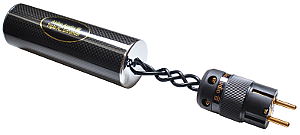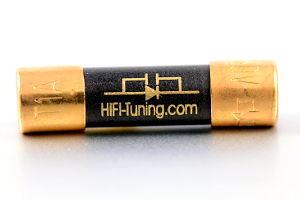Are you looking for the perfect sound, are you unsatisfied with your current set – up and do you often feel as if your music is unpleasantly loud or irritating? Are you contemplating exchanging components for supposedly better and usually more expensive parts? Maybe that’s unnecessary! Maybe a modest investment is all you need to discover something you had never expected.
Design and how the Enhancer works
The Triple AC Enhancer is made by hand and weighs 650 grams, divided over a total length of 330 millimetres.
Inside the 160 millimetres long carbon housing three separate compartments contain uniquely developed active materials, which are connected to the power cables.
Each compartment is stabilised by synthetic resin to minimise microphonic effects. The housing doesn’t contain any electronics and all power connections are led to a neutral. Which materials are used and how they work exactly isn’t revealed by the manufacturer, but Akiko Audio does state that the Enhancer can eliminate interference from high-frequency electromagnetic fields, which can be proven through measurements.
Setting it up
For the test I used a high quality power strip with three connections. It is advised to connect the Enhancer as close as possible to the power source of the amplifier and primary audio device. Akiko Audio says that a seven days break – in period of continuous operation is needed to develop the effect.
First impressions during the break – in period I connected a media receiver and Blu-Ray player to the amplifier at a distance of about 4 metres, well away from the enhancer. In addition to an instant increase in sharpness and contrast, the sound level of the TV and home cinema set went through a number of different changes.
After a while I had to turn up the volume of the media receiver. Three days later the sound image became stable, leading to a steady saturation of the amplifier’s volume, even at low levels. Although I had to keep the home cinema set and amplifier at a low volume from now on, I could still hear an impressive spatial representation, fine details, more power and malleability.
These successes made me even more excited for the thorough testing. I couldn’t wait to hear my favourite device, the record player, on day eight.
Tsunami – the Enhancer after the break – in period
This Japanese word literally translates to harbour wave. In this case, the harbour was my heart and the overwhelming wave was brought forth by the set-up.
After the break – in period, the Triple AC Enhancer gave me the following impressions.
Yello 1980 – 1985 THE NEW MIX IN ONE GO / Double LP / Sometimes (Dr. Hirsch) / Base for Alec:
For the first time in 31 years I put on this record, but even so it released a flood of unusual impressions.
The sound was filled with many subtle details. The synthetic sound was rendered in a spectacular spatial representation, sounding almost acoustically sculpted. I realised that the sharp line a top the image was missing, having been replaced by organically formed sounds. Dieter Meyer’s voice sounded striking and melodious at the centre of this panoramic view.
Everything flattered the ear in a remarkable fashion, was undistorted and relaxed to listen to. Especially impressive was the bass the Enhancer produced, which I neither knew my Spendor SP1 (manufactured in 1985) was cap able of, nor had expected it to be. This speaker legend had the reputation of being less present in the low – frequency range, a property it owed to its neutrality and which was improved upon greatly in recent years by optimising the chain. That it was capable of such a performance in the low surprised me.
The next piece, Base for Alec, has often been criticised for its unpleasant rendering of the small electric guitar additions. With the Enhancer however, I was able to enjoy even the sharpest sounds without a problem. It was fun, goose bumps, emotion, ease and pleasure; I got caught up in the wave and was carried away.
Paul Hillier / Proensa / ECM NEW SERIES / Reis glorios:
Akiko Audio advertises that voices and acoustic instruments profit especially from the Enhancer. I
listened to Reis glorios, which began with a soft and quivering bowed psaltery, alternated by a simple melody on the lute. These instruments formed themselves sharply in the room, but became music instead of a metallic noise.
The sounds were delicate and organic. This record was produced digitally and then pressed into Vinyl and became inspirational because of its exceptional quality. Slowly the rhythm grew as Hillier raised his voice. Again I was swept away by a wave. Everything was reduced to the essentials: voice and instrument, which left space and time forgotten.
I gave myself over to the sound, letting myself be immersed without thinking about the technicality or quality of the reproduction.
What it offered seemed overwhelming in its beauty and purity and deeply moved me.
Grèce / Chants sacrés de la tradition byzantine vol. 1 / harmonia mundi France 1977 / Kherouvikon (Hymne des Chérubins):
This choral began with the deep male voices of the Téodore Vassilikos ensemble, which produced long – drawn sonorous O-tones.
When the lead singer recited the 4th century liturgical text, the volume of his voice went through multiple stages.
The delicate presence of his clear and shining over tones carried far and wide thanks to the church acoustics. His song reached its first climax and unfolded its full potential, which was presented clean and pure.
An overwhelming moment. I was touched by the beauty when these people called for their god.
Georges Bizet / Carmen / Deutschen Oper Berlin Choir/Conductor: Hermann Lüddecke / Schock /Prey / Ludwig /second act-Zigeunerlied / EMI-Electrola 1961:
This production is characterised by an exceptional sound quality, especially regarding its spatial dimension. The voices are impressively preserved. Slowly the Zigeunerlied begins to build. Lady Ludwig’s voice appeared strong and convincing from the start.
The rhythm grew, their song became more intensive, gained strength, seemed detached from the devices, radiated powerfully from
within, and had nothing to do with Hi-Fi anymore.
This piece sent shivers down my spine, overwhelming me once more. Everything was presented clean and without disruptions, making me forget I was sitting in front of my set-up. As the spatial dimension grew larger, the distances to the sound remained in natural proportions.
Desert–Listening without the Enhancer
Obviously there was a time when, from today’s point of view, I would have been satisfied with the unbearable conditions of my sound, since I discovered the possibilities of power supply optimization relatively late. For this negative test I removed the Enhancer for three days, so my set-up ran without any improvements to the energy supply.
Yello 1980-1985 THE NEW MIX IN ONE GO /Double LP / Sometimes (Dr. Hirsch) / Base for Alec:
Again I was surprised by the results. The spatial dimension of the sound image fell apart. The bass described above had slimmed down, became blurred and lost much detail. Dieter Meyer’s voice wavered fragmented in space.
I couldn’t listen for very long, especially because many synthetic sounds in the high-frequency range became too distorted. This extreme opposite to the results of using the Enhancer made me stop playing the record within seconds.
Paul Hillier / Proensa / ECM NEW SERIES / Reis glorios:
With acoustic music the differences became even clearer. The rendering became smaller and moved sharply to the left. Bowed psaltery, lute and voice sounded like metal. The realism had disappeared, as well as the beautiful thoughts and feelings. It was no pleasure to listen to.
Grèce / Chants sacrés de la tradition byzantine vol. 1 / harmonia mundi France 1977 / Kherouvikon (Hymne des Chérubins):
Absent were: accustomed naturalness, space, contrast, details, subtle nuances and complex overtones. Distortions became so intolerable when the voice was raised, that I quickly switched off the record.
Georges Bizet / Carmen / Deutschen Oper Berlin Choir/Conductor: Hermann Lüddecke / Schock /Prey / Ludwig /second act-Zigeunerlied / EMI-Electrola 1961:
In this record the differences were drastic. The sound shrunk to the size of a model railroad track. Christa Ludwig mutated into a dwarf with a powerful voice that unfortunately had more to do with Hi-Fi than human beings.
No radiance from within, little detail, no pleasure, but rather negative emotions. As the dimension changed, the relative distances to the sound became skewed. The motivation to continue listening vanished after only a few seconds.
Conclusions
The Triple AC Enhancer makes it possible to let go of technology and get pure music in return. The sound it offers no longer comes across as metallic, but is instead turned into a detailed and realistic image. Voices shine through shimmering and complex overtones. The low-frequency range gains in presence and size.
Merely one Enhancer already gives you the pleasure of listening to high quality music and awakens a desire to rediscover your entire music
collection. This is all offered without any disruptions, such as distortions or reductions of the sound image. And in the end, only music remains.
Price and contact information
Triple AC Enhancer 295,- euro (as of September 2016).
The manufacturer offers a 14-day ‘not satisfied–money back’ guarantee.
Purchasable via their web shop www.akikoaudio.com
Sales:
Akiko Audio
Churchilllaan 69
6226CT Maastricht
The Netherlands
Tel: +31(0)43-8515561
E-mail: [email protected]



